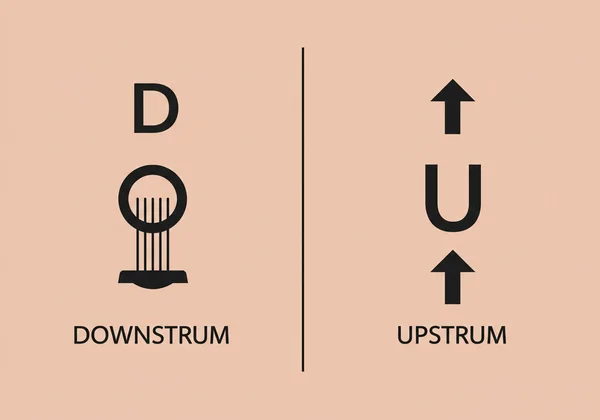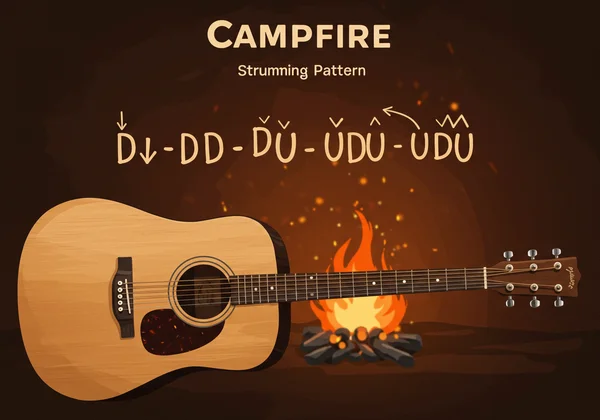Play Guitar Online: 4 Easy Strumming Patterns for Beginners
You've finally done it. You've memorized a few essential chords like G, C, and D. But when you try to play your favorite song, something feels off. The chords sound clunky and disconnected, not like the fluid, musical sound you hear on the radio. That missing piece is rhythm, and this guide is here to help you find it. We'll explore four easy guitar strumming patterns that will transform your playing from a series of notes into real music. Can I learn guitar online for free? Yes, you absolutely can, and you can practice every pattern in this guide right now on our free online guitar simulator.

First, Understand How to Strum a Guitar
Before we jump into the patterns, let's cover the basics. Strumming is simply the act of brushing your fingers or a pick across the guitar strings to sound a chord. The magic happens in the rhythm of those strums—the combination of downward and upward motions that create a groove. A steady rhythm is the foundation of almost every song you've ever heard, and mastering it is your next big step as a guitarist.
Think of strumming as the heartbeat of a song. It provides the energy, the emotion, and the pulse that makes people want to tap their feet. Without a solid strumming pattern, even the most complex chords can sound lifeless.
Reading Strumming Notation: The Basics of Down & Up
To learn patterns, you need to understand the language used to write them. Luckily, it's incredibly simple. Guitar strumming is typically notated with arrows or letters representing the direction of your strum.
-
D (or ↓): Downstrum. This means you strum from the thickest string (low E) down to the thinnest string (high e).
-
U (or ↑): Upstrum. This means you strum from the thinnest string (high e) up towards the thickest string (low E).

Throughout this guide, we'll use "D" for downstrums and "U" for upstrums. For example, a pattern written as "D U D U" means you would strum down, then up, then down, then up, all in a steady rhythm.
How to Play Guitar Rhythm on Your Keyboard
One of the best things about modern technology is the ability to practice anywhere. Our virtual guitar is designed with a unique keyboard mapping feature that lets you feel the rhythm. You can assign specific keys to perform downstrums and upstrums, giving you a more tactile and immersive experience than just clicking with a mouse. This is perfect for building muscle memory for play guitar rhythm without even owning a physical instrument.
Before you start the exercises below, open our tool and get comfortable with the controls. You can play single notes to warm up or jump right into playing full chords. This immediate, hands-on practice is the fastest way to internalize these patterns.
Your First Beginner Strumming Exercises
Ready to make some music? Grab a simple chord you know, like G major or C major. We will use one chord to practice each of these beginner strumming exercises. The goal isn't to change chords yet; it's to get the right hand's rhythm locked in and smooth. Let's begin.
Pattern #1: The Steady Foundation (All Downstrums)
This is the simplest pattern and the most important for developing your internal clock. It focuses purely on consistent timing, which is a core pillar of good musicianship. Mastering these rhythm basics is essential.
The Pattern: D - D - D - D
How to Play It:
- Hold down a C chord on the virtual guitar.
- Count out loud: "1, 2, 3, 4."
- On each number, perform a steady downstrum.
- Keep the time between each strum exactly the same. It should sound like a ticking clock: Strum... Strum... Strum... Strum.
Focus on making each strum sound even and confident. This pattern is the backbone of countless rock and folk songs. Once you feel comfortable, try switching to a G chord without losing the beat. Try it now on our free online guitar.
Pattern #2: The Classic Campfire (D-DU-UDU)
If you have ever sat around a campfire and heard someone playing guitar, chances are they were using this pattern. It is arguably the most common and versatile strumming pattern in all of popular music, especially for acoustic guitar.
The Pattern: D - D U - U D U

How to Play It:
- This one can be tricky, so let's break it down. Think of it in three parts: [D] ... [D U] ... [U D U].
- Start with a strong downstrum on beat 1.
- The second beat is a quick down-up motion.
- The third and fourth beats are a fluid up-down-up.
- Count it like this: "ONE, two-and, three-and-four-and."
This pattern has a natural, flowing feel once you get it right. It fills out the sound beautifully and makes even a single chord sound like a complete song. This is the perfect pattern to practice your chord changes with. See if you can play the pattern four times on a C chord, then switch to a G chord and play it four more times without stopping. It’s a challenge, but you can practice guitar online until it feels effortless.
Pattern #3: The Simple Pop Beat (D-D-U-D-U)
This pattern introduces a little bit of syncopation, which is a fancy word for rhythms that play off the main beat. This gives the pattern a groovier, more modern musical feel and is found in thousands of pop and indie songs.
The Pattern: D - D U - D U
How to Play It:
- Start with two firm downstrums on beats 1 and 2.
- Follow immediately with an upstrum.
- Pause for a moment, then play a final down-up.
- Count it like this: "ONE, TWO-and, ... , FOUR-and." The pause on beat 3 is just as important as the strums.
This pattern is great for adding energy to a song. It has a driving quality that pushes the music forward. Practice it slowly at first, paying close attention to the space you leave on the third beat.
Pattern #4: The Driving Rock Beat (D-D-U-U-D-U)
Ready to rock? This pattern is perfect for it. It's energetic, powerful, and a staple in rock and roll. While it sounds great on an acoustic, this pattern truly comes alive with a bit of distortion.
The Pattern: D - D U - U D U
How to Play It:
- This is a variation of the "Campfire" pattern but with a different emphasis that gives it a rock edge.
- Start with two downstrums on beats 1 and 2.
- The rest of the pattern is a rapid "up-up-down-up" motion.
- Count it like this: "ONE, TWO, and-four-and-a."
This pattern is all about energy and attitude. Head over to our virtual electric guitar tool, switch the sound to the electric guitar tone, and play this pattern with a G chord. You'll instantly feel the power and understand why this rhythm is a rock classic. Try our free tool and unleash your inner rockstar.
Start Sounding Like a Real Guitarist Today
Rhythm is what separates a beginner from an experienced player. By mastering these four fundamental strumming patterns, you are building the foundation you need to play thousands of songs. The key is consistent practice. Don't be discouraged if it feels awkward at first—every guitarist has been where you are now.
Remember that clunky, disconnected sound? Daily practice is the antidote. Just 10 minutes on our online guitar can transform awkward chord changes into fluid, confident music. Pick a pattern, choose your favorite sound—maybe that crunchy electric tone?—and just play. Soon, the rhythm will be second nature. You've got this. Play guitar now and start your journey.
Frequently Asked Questions About Playing Guitar Online
How do I play guitar online with a keyboard?
Playing guitar online with a keyboard is one of the best features of our tool. On our platform, we've mapped the guitar strings and common chords to keys on your computer keyboard. This allows you to press keys to trigger downstrums, upstrums, or entire chords, providing a much more fluid and rhythmic experience than clicking with a mouse. This method helps you develop a feel for timing and rhythm, which is crucial for learning to play.
Can I learn guitar online for free?
Absolutely! The biggest barrier to learning guitar is often just starting. That's why tools like our free virtual guitar exist—to let you dive in and learn chords, practice scales, and master strumming patterns without spending a dime or worrying if you'll 'stick with it.' Our free online guitar tool provides a complete, interactive virtual guitar at no cost. When combined with free video tutorials and articles like this one, it's the perfect, no-risk way to unlock your passion for music and build a strong foundation before deciding whether to invest in a physical instrument.
What are the most basic guitar chords for beginners to practice with?
For beginners, the best chords to start with are often called "open chords" because they use open strings and are easier to press down. The most fundamental chords are G Major, C Major, D Major, E Minor, and A Minor. With just these five chords, you can play a surprising number of popular songs. They are the perfect chords to use when practicing the strumming patterns in this guide on our online guitar tool.